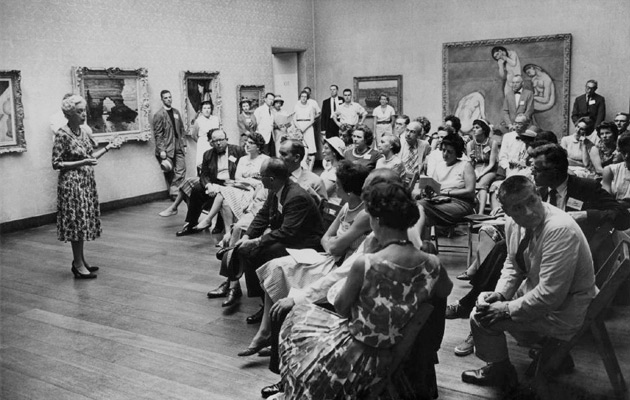In 1970, a debate was under way at the Fogg Museum about whether female staff should be permitted to wear pants. Fogg director Agnes Mongan was opposed, as evidenced by a memo from the time, now in the Harvard Art Museums Archives. She was mindful of the obstacles still facing women and how they were perceived in the workplace: it was only after many years of institutional opposition to women in supervisory positions at Harvard that she had become one of the first women to oversee a major art museum in the United States.
When “Miss Mongan,” as she was known, began her career at the Fogg as a research assistant to director Paul J. Sachs in 1928, women were limited in how far they could advance. Harvard barred women from being curators, and so, in 1937, Mongan was made keeper of drawings until the university lifted its ban in 1949. She was then appointed curator of drawings, a title she held until her retirement.
Mongan became an authority on drawings, helping professionalize a discipline that “previously had been a field for dilettantes and connoisseurs,” recalled Eunice Williams, a former assistant curator of drawings and student of Mongan. She spent 10 years exploring and documenting the Fogg’s collection of drawings, resulting in the two-volume Drawings in the Fogg Museum of Art (1940), coauthored with Sachs. This was the first comprehensive catalogue of drawings to be published in the United States. According to Consultative Curator of Drawings William W. Robinson, the book was always known as having been written by “Mongan and Sachs”—not the other way around—a reflection of the fact that the work was largely completed by her.
Mongan published more than 130 works, mostly related to drawings, and organized numerous exhibitions, including a centennial show of drawings by Ingres and an exhibition of drawings by Giovanni Domenico Tiepolo.
“She was conscientious as a mentor,” remembers Williams. “She set an example and expected the same professionalism in others. That professionalism extended to manners and dress. It was a matter of decorum and was especially important for women who expected to be taken seriously.”
“Concerning the matter of the female staff wearing slacks to work, I will not have them wear Levis,” Mongan wrote in a 1970 memo to her assistant Suzannah Doeringer. “If it is a handsome, well-tailored pant suit I sometimes think the pant suits are far more decent than the mini-skirts, but then you know I do not like mini-skirts. I can’t wait for them to be over.”
Mongan stepped down as director of the Fogg in 1971, and finally retired as curator in 1975. But she continued to teach, lecture, and write for the next several decades, publishing her last catalogue, David to Corot: French Drawings in the Fogg Art Museum, just before her death, in 1996.
The Harvard Art Museums Archives has extensive holdings related to Mongan, including her personal and professional papers, images, and audio recordings, which are available to researchers by appointment.
Brooke McManus is the archives assistant in the Harvard Art Museums Archives.

